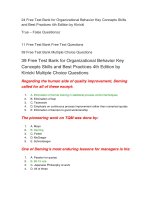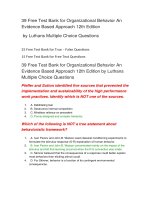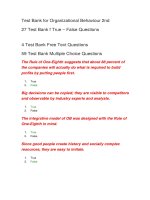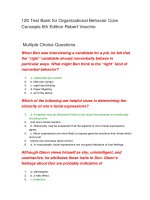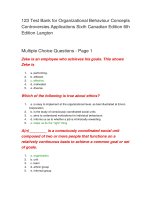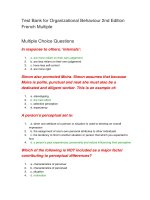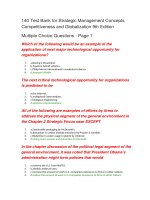123 test bank for organizational behaviour concepts controversies applications sixth canadian edition 6th edition langton
Bạn đang xem bản rút gọn của tài liệu. Xem và tải ngay bản đầy đủ của tài liệu tại đây (191.33 KB, 29 trang )
123 Test Bank for Organizational Behaviour Concepts
Controversies Applications Sixth Canadian Edition 6th
Edition Langton
Multiple Choice Questions - Page 1
Zeke is an employee who achieves his goals. This shows Zeke is
1.
a. performing.
2.
b. efficient.
3.
c. effective.
4.
d. motivated.
5.
e. diverse.
Which of the following is true about ethics?
1.
a. is easy to implement at the organizational level, as best illustrated at Enron
Corporation
2.
b. is the study of consciously coordinated social units
3.
c. aims to understand motivations for individual behaviours
4.
d. informs us as to whether a job is intrinsically rewarding
5.
e. helps us do the “right” thing
A(n) ________ is a consciously coordinated social unit composed of two
or more people that functions on a relatively continuous basis to achieve
a common goal or set of goals.
1.
a. organization
2.
b. unit
3.
c. team
4.
d. ethnic group
5.
e. informal group
A characteristic of Johan’s department is that there is a broad mix of
people in terms of gender, race and ethnicity. This is known as
1.
a. diversity.
2.
b. empowerment.
3.
c. groupthink.
4.
d. ethics.
5.
e. individual differences.
Individuals face various challenges in organizational settings. Which of
the following organizational challenges is OB be best suited for
1.
a. maintaining stock prices.
2.
b. profit projection.
3.
c. setting common goals.
4.
d. time management.
5.
e. protocol on the job.
Sanjay is a very motivated employee who typically does work that is not
part of his formal job responsibilities but which furthers the objectives of
the organization. This is known as
1.
a. groupthink.
2.
b. organizational citizenship behaviour.
3.
c. diversity.
4.
d. individual differences.
5.
e. efficiency.
Which of the following statements about organizational behaviour (OB) is
false?
1.
a. OB is relevant only in employment situations.
2.
b. OB can shed light on the interactions among family members.
3.
c. OB can be used in community settings like children’s daycare centres.
4.
d. OB can be applied to any organization in order to make it run more effectively.
5.
e. OB focuses on 3 levels of behaviour that can occur in any organization.
Tina is known to produce large amounts of work without having to exert
much effort. Tina is
1.
a. diverse.
2.
b. efficient.
3.
c. effective.
4.
d. motivated.
5.
e. ethical.
In all of his undertakings at work, Norm is a leader who looks to do the
right thing. This refers to his
1.
a. efficiency.
2.
b. effectiveness.
3.
c. performance.
4.
d. ethics.
5.
e. motivation.
When managers empower their employees they are
1.
a. re-engineering the workplace.
2.
b. establishing a new program of TQM.
3.
c. developing new styles of leadership.
4.
d. developing ways of more effectively controlling work.
5.
e. putting employees in charge of what they do.
Which of the following is true about empowerment?
1.
a. was embraced by classical OB experts
2.
b. managers learn how to give up control
3.
c. allows employees to delegate more to peers
4.
d. focuses primarily on job productivity
5.
e. employees to do less work
What are the three levels of behaviour in organizations that OB is
concerned with?
1.
a. experience, goals and configuration
2.
b. individual, group, and structure
3.
c. structure, social units and teams
4.
d. group, structure and political
5.
e. interpersonal, personal and group
Whereas ________ requires organizations to be flexible in working with
organizations and people from different countries, ________ requires
employees to be flexible when working with others within the
organization.
1.
a. workforce diversity; globalization
2.
b. globalization; workforce diversity
3.
c. culture; diversity
4.
d. culturization; workforce diversity
5.
e. globalization; culturization
Which of the following is not considered an organization?
1.
a. church
2.
b. university
3.
c. military unit
4.
d. all 45 year old adults in a community
5.
e. municipal, provincial and federal government agencies
A high rate of employee turnover increases
1.
a. bottom up management.
2.
b. recruiting costs.
3.
c. positive organizational scholarship.
4.
d. workplace diversity.
5.
e. individual difference.
Working with others and workplace diversity are challenges at the
________ level.
1.
a. ethical
2.
b. individual
3.
c. group
4.
d. organizational
5.
e. motivational
A consciously coordinated social unit composed of a group of people that
function on a relatively continuous basis to achieve a common set of
goals is known as a(n)
1.
a. work group.
2.
b. team.
3.
c. organization.
4.
d. society.
5.
e. task force.
As employees move beyond their traditional function of labour, what roles
are they asked to play?
1.
a. making job satisfaction an extremely high priority
2.
b. focusing on making workplaces pleasant environments
3.
c. sharing in decision-making processes
4.
d. managing global competition
5.
e. following orders
The practice of sharing more power with employees is known as
1.
a. risk taking.
2.
b. empowerment.
3.
c. sociology
4.
d. psychology.
5.
e. contingency.
Which of the following is an example of being an efficient organization or
employee?
1.
a. operating a hospital at the lowest possible cost while achieving higher output
2.
b. being the most pleasant real estate broker in Toronto
3.
c. being a telemarketer who makes the required number of calls each day
4.
d. being a sales person who acquires the most clients of anyone in the company
5.
e. being an instructor who teaches larger classes than other instructors
Giselle is using a spreadsheet to measure each employee’s efficiency and
effectiveness. This is known as the employee’s
1.
a. performance.
2.
b. productivity.
3.
c. diversity.
4.
d. culture.
5.
e. ethics.
Tom noticed that there is a wide variety of personalities, perception and
attitudes among his staff members, which he believes affects how they
behave. These are known as
1.
a. empowerment.
2.
b. job satisfaction.
3.
c. groupthink.
4.
d. individual differences.
5.
e. motivation.
Why should you increase your understanding of workforce diversity?
1.
a. to be politically correct
2.
b. the Canadian workplace is becoming more homogenous
3.
c. to eliminate differences amongst employees
4.
d. the Canadian workplace is becoming more heterogeneous
5.
e. to communicate more proficiently
A field of study that investigates the impact of individuals, groups, and
structure on behaviour within organizations is known as
1.
a. psychology.
2.
b. sociology.
3.
c. social psychology.
4.
d. anthropology.
5.
e. organizational behaviour.
Employee productivity, developing effective employees, and developing a
positive work environment are challenges at the ________ level.
1.
a. ethical
2.
b. individual
3.
c. group
4.
d. organizational
5.
e. motivational
________ is achievement of goals.
1.
a. Efficiency
2.
b. Effectiveness
3.
c. Productivity
4.
d. Motivation
5.
e. Job satisfaction
Everyone loves to work for Peter because he gives them complete
responsibility for what they do. This is known as
1.
a. motivation.
2.
b. individual differences.
3.
c. empowerment.
4.
d. diversity.
5.
e. ethics.
Which of the following is the most accurate description of ethics?
1.
2.
3.
a. Ethics are easy to implement at the organizational level as best illustrated at
Enron Corporation.
b. Ethics look at past personal traumas.
c. Ethics is common sense that informs us as to whether our actions are right or
wrong.
4.
d. Ethics is the study of moral values that guide our behaviour.
5.
e. Ethics help us do the “right” thing.
Organizational behaviour is generally defined as a field of study that
1.
a. investigates how organizations effectively face competition.
2.
b. investigates the impact that individuals, groups, and structure have on
behaviour within organizations.
3.
c. attempts to understand and solve problems regarding individual behaviour on
and off the job.
4.
5.
d. seeks ways and means to match human effort with technology.
e. examines how the structure of different organizations contributes to, or inhibits,
effective communication.
Allison and Gail are both university students studying for a final exam in
OB. Both students have a goal of making a grade of 90% or better despite
the time pressures they face. Gail studied diligently for six hours and
made a grade of 92%. Allison studied diligently for nine hours and also
made a grade of 92%. Which of the students was effective?
1.
a. only Gail
2.
b. only Allison
3.
c. neither Gail or Allison
4.
d. both Gail and Allison
5.
e. It is impossible to tell from the information given.
Which of the following situations would likely receive the least benefit
from studying Organizational Behaviour(OB) techniques?
1.
a. voluntary community groups
2.
b. large family situations and interactions
3.
c. post-secondary education student study groups
4.
d. religious organizations
5.
e. pre-teen paper routes
Which of the following topics is generally considered to be outside the
field of OB?
1.
a. therapy
2.
b. absenteeism
3.
c. employment turnover
4.
d. productivity
5.
e. job satisfaction
Toronto-based Dell Canada’s technical service lines are handled by
technicians located in India. This is an example of
1.
a. repatriation.
2.
b. immigration.
3.
c. emigration.
4.
d. nationalism.
5.
e. outsourcing.
Workforce diversity is
1.
a. counter-productive to job satisfaction.
2.
b. the variance among workers’ pay scales.
3.
c. the distribution of workers by hair colour.
4.
d. the differences among employees based on age.
5.
e. the ratio of assistants to managers.
How organizations develop human strengths, foster vitality and resilience,
and unlock potential is called
1.
a. orientation.
2.
b. groupthink.
3.
c. positive organizational scholarship.
4.
d. human dynamics.
5.
e. organizational politics.
73 Free Test Bank for Organizational Behaviour
Concepts Controversies Applications Sixth Canadian
Edition 6th Edition Langton Multiple Choice Questions
- Page 2
The OB subject of “organizational culture” has been most influenced by
which behavioural science discipline?
1.
a. anthropology
2.
b. psychology
3.
c. social psychology
4.
d. political science
5.
e. sociology
The behavioural science that underlies organizational culture is known as
1.
a. psychology.
2.
b. sociology.
3.
c. social psychology.
4.
d. anthropology.
5.
e. political science.
If today’s managers positively address and manage workforce diversity,
which of the following increases?
1.
a. employee turnover
2.
b. miscommunications
3.
c. interpersonal conflicts
4.
d. creativity and innovation
5.
e. ineffective decision making
If we understand the written and unwritten rules in a structured situation
then human behaviour becomes
1.
a. predictable.
2.
b. predetermined.
3.
c. manageable.
4.
d. controllable.
5.
e. unpredictable.
In the study of OB, common sense is generally replaced by
1.
a. systematic study.
2.
b. generalization.
3.
c. listening.
4.
d. prediction.
5.
e. unstructured observation.
The most significant contributions to OB with respect to implementing
change and reducing barriers to its acceptance has been made by
1.
a. psychology.
2.
b. sociology.
3.
c. social psychology.
4.
d. political science.
5.
e. anthropology.
The behavioural science that underlies work design and performance
appraisal is known as
1.
a. sociology.
2.
b. psychology.
3.
c. social psychology.
4.
d. anthropology.
5.
e. political science.
Which behavioural science discipline contributes to OB’s understanding
of group decision-making processes?
1.
a. anthropology
2.
b. psychology
3.
c. social psychology
4.
d. sociology
5.
e. political science
The behavioural science that underlies communication and group
processes is known as
1.
a. psychology.
2.
b. sociology.
3.
c. social psychology.
4.
d. anthropology.
5.
e. political science.
Which of the following aspects of an organization has this chapter
focused the least on?
1.
a. common goals
2.
b. two or more people
3.
c. change
4.
d. co-ordination
5.
e. continuous basis
Various challenges exist at the organizational level. Which of the following
would not be considered an organizational challenge?
1.
a. developing and implementing successful managerial intervention techniques
2.
b. appreciating the diverse workforce
3.
c. competing in global markets
4.
d. hiring and developing effective employees
5.
e. overall productivity and output
Members of groups must contend with various challenges on the job.
Which of the following would not be considered a group challenge?
1.
a. understanding workforce diversity
2.
b. working with others who do not share a common ethnic background
3.
c. developing an atmosphere of team spirit and support
4.
d. empowerment
5.
e. working with others from different cultures
Considering behaviour within the context in which it occurs is known as
the ________ approach.
1.
a. absolute
2.
b. rational
3.
c. contingency
4.
d. empowerment
5.
e. behavioural
Why do organizations that have OCB outperform those that do not?
1.
a. OCB promotes the effective functioning of the organization.
2.
b. OCB employees are easier to supervise.
3.
c. OCB increases job satisfaction, increasing productivity.
4.
d. OCB decreases recruitment, selection and training, because turnover is less.
5.
e. OCB is rewarded by increased opportunities for promotions.
Individual-level variables that have been shown to affect group and
organizational behaviour include
1.
a. technology.
2.
b. organizational culture.
3.
c. perception.
4.
d. human resource policy.
5.
e. group behaviour.
From which of the following behavioural sciences has the study of
“people’s influence on one another”?
1.
a. anthropology
2.
b. social psychology
3.
c. psychology
4.
d. political science
5.
e. sociology
Individuals face various challenges on the job. Which of the following
would not be considered an individual challenge?
1.
a. maintaining job satisfaction
2.
b. sustaining workplace motivation
3.
c. creating a positive work attitude
4.
d. focusing on global competition
5.
e. behaving ethically on the job
The behavioural science which underlies conflict and power is known as
1.
a. psychology.
2.
b. sociology.
3.
c. social psychology.
4.
d. anthropology.
5.
e. political science.
Organizational behaviour has implications for all personnel in the
workplace. Some of OB’s challenges and opportunities include all of the
following except
1.
a. it acknowledges employees are forces of innovation and change.
2.
b. it offers specific insights to improve interpersonal and people skills.
3.
c. it helps us learn to balance the relationship between efficiency of resources with
effectiveness of delivery.
4.
d. it facilitates the improvement of quality and employee productivity.
5.
e. it reinforces the importance of traditional methods of management.
Amongst the research methods in OB, which would most likely employ
simulated and controlled settings?
1.
a. survey studies
2.
b. meta-analysis
3.
c. field studies
4.
d. case studies
5.
e. laboratory studies
The systematic approach to the study of OB is most consistent with
1.
a. cause-effect relationships.
2.
b. common sense.
3.
c. unstructured observation.
4.
d. gut feelings.
5.
e. predictability.
Generally, the best method for obtaining knowledge regarding human
behaviour is the
1.
a. common sense approach.
2.
b. observational approach.
3.
c. systematic approach.
4.
d. theoretical approach.
5.
e. intuitive approach.
When we say that OB concepts must reflect situational conditions, we
mean
1.
a. behaviour can never be predicted.
2.
b. predicting certain behaviour depends on the context of a structured situation.
3.
c. predicting certain behaviour depends on intuition.
4.
d. regular and unchanging conditions .
5.
e. only certain conditions can be predicted.
Allison and Gail are both university students studying for a final exam in
OB. Both students have a goal of making a grade of 90% or better despite
the time pressures they face. Gail studied diligently for six hours and
made a grade of 92%. Allison studied diligently for nine hours and also
made a grade of 92%. Gail appears to be the more productive student
because
1.
a. her efficiency seemed to be better than Allison’s.
2.
b. her effectiveness seemed to be better than Allison’s.
3.
c. her IQ is higher than Allison’s.
4.
d. Allison didn’t seem to think that time is an important factor.
5.
e. It is impossible to tell from the information given.
Among the research methods in OB, which would most likely employ
questionnaires and interviews?
1.
a. case studies
2.
b. meta-analysis
3.
c. survey studies
4.
d. field studies
5.
e. laboratory studies
The OB subject of “motivation” has been most influenced by which
behavioural science discipline?
1.
a. psychology
2.
b. social psychology
3.
c. sociology
4.
d. political science
5.
e. anthropology
The OB subject of “power” has been most influenced by which
behavioural science discipline?
1.
a. psychology
2.
b. social psychology
3.
c. anthropology
4.
d. political science
5.
e. sociology
Organization behaviour has few
1.
a. theories.
2.
b. contingencies.
3.
c. models.
4.
d. absolutes.
5.
e. field studies.
Predictability of behaviour is increased if we know
1.
a. that the person is rational.
2.
b. how the person perceives the situation.
3.
c. that behaviour is caused.
4.
d. the person’s age.
5.
e. the person’s level of education.
The approach to organization behaviour which suggests that its answers
“depend upon the situation” is called the
1.
a. behavioural approach.
2.
b. mechanistic approach.
3.
c. organic approach.
4.
d. contingency approach.
5.
e. field study approach.
Amongst the research methods in OB which would most likely employ the
statistics of many different studies?
1.
a. laboratory studies
2.
b. meta-analysis
3.
c. field studies
4.
d. survey studies
5.
e. case studies
By putting people first, it is thought that employees will become more
effective and hence more productive. What are some of the challenges
inherent in putting people first?
1.
a. initial loss in production
2.
b. cultural confusion
3.
c. blurring of lines between management and labour
4.
d. balancing cultural sensitivity with the bottom line
5.
e. incompatibility between differing cultural backgrounds
A major theme underlying the process of organizational behaviour is the
belief that human behaviour is
1.
a. opaque.
2.
b. instinctual.
3.
c. unpredictable.
4.
d. intuitive.
5.
e. knowable.
In OB, looking at relationships, attempting to attribute causes and effects,
and basing conclusions on scientific evidence is referred to as
1.
a. a contingency approach.
2.
b. an absolute approach.
3.
c. a consistency approach.
4.
d. systematic study.
5.
e. intense scrutiny.
OB looks at three basic levels of analysis and organization. The group
level includes all of the following independent variables except
1.
a. leadership.
2.
b. group decision making.
3.
c. organizational culture.
4.
d. work teams.
5.
e. group structure.
Looking in-depth at single situations in order to gain insight into
organizational behaviour relates to the examination of
1.
a. case studies.
2.
b. laboratory studies.
3.
c. survey studies.
4.
d. meta-analysis.
5.
e. field studies.
A major characteristic of empowerment is
1.
a. re-engineering the workplace.
2.
b. establishing a new program of TQM.
3.
c. developing new styles of leadership.
4.
d. developing ways of more effectively controlling work.
5.
e. putting employees in charge of what they do.
Allison and Gail are both university students studying for a final exam in
OB. Both students have a goal of making a grade of 90% or better despite
the time pressures they face. Gail studied diligently for six hours and
made a grade of 92%. Allison studied diligently for nine hours and also
made a grade of 92%. Which of the following statements is most
accurate?
1.
a. Gail is more efficient than Allison.
2.
b. Allison is more efficient than Gail.
3.
c. Gail is more effective than Allison.
4.
d. Allison is more effective than Gail.
5.
e. It is impossible to predict efficiency or effectiveness in this case.
True - False Questions
There are certain fundamental inconsistencies underlying the behaviour
of most individuals that can be identified and modified to reflect individual
differences.
1.
True
2.
False
There is currently little discussion and disagreement over specific OB
findings, theories and method.
1.
True
2.
False
Ethics can inform us whether our individual actions are right or wrong;
however, organization and group actions are too complex for ethics to
apply.
1.
True
2.
False
Contributions in the area of power are more likely to come from
psychologists than from sociologists.
1.
True
2.
False
Sociology has contributed to our understanding of group dynamics.
1.
True
2.
False
The term organization generally refers to business firms but excludes
government, social service agencies and other public organizations.
1.
True
2.
False
Organizational culture finds its roots in anthropology.
1.
True
2.
False
Organizations as a rule do not have informal leadership opportunities.
1.
True
2.
False
The external dimension of the competing values framework focuses on
employee needs and production processes.
1.
True
2.
False
Learning, perception and personality have been OB topics whose
contributions have generally come from psychology.
1.
True
2.
False
There are many theories that can explain organizational behaviour
through generalization.
1.
True
2.
False
If diversity is ineffectively managed, high turnover and miscommunication
can result, creating an environment, which hinders achievement of
organizational goals.
1.
True
2.
False
Organizations that have employees with high OCB (organizational
citizenship behaviour) outperform organizations that have employees with
low OCB.
1.
True
2.
False
Voluntary and involuntary permanent withdrawal of an employee from an
organization is termed “absenteeism.”
1.
True
2.
False
The behaviour of individuals in a structured situation is similar to their
behaviour when they are in unstructured situations.
1.
True
2.
False
A basic research method of OB is survey studies that look at employing
questionnaires and interviews.
1.
True
2.
False
The contingency approach considers behaviour objectively.
1.
True
2.
False
Much of OB is relevant beyond the workplace.
1.
True
2.
False
Empowerment means giving employees more decision-making authority.
1.
True
2.
False
The issues of conflict and power are major topics of concern to
sociologists as well as OB in an organizational situation.
1.
True
2.
False
Since guaranteed jobs are no longer part of the Canadian work
environment, it is prudent to keep focused on past practices and
traditions since they have worked well and are likely to succeed again.
1.
True
2.
False
The flexibility-control dimension of the competing values framework
refers to the competing demands of organizations to stay focused on the
past versus preparing for the need for more flexibility in the future.
1.
True
2.
False
Whereas globalization focuses on differences between people from
different countries, workforce diversity addresses differences among
people within given countries.
1.
True
2.
False
